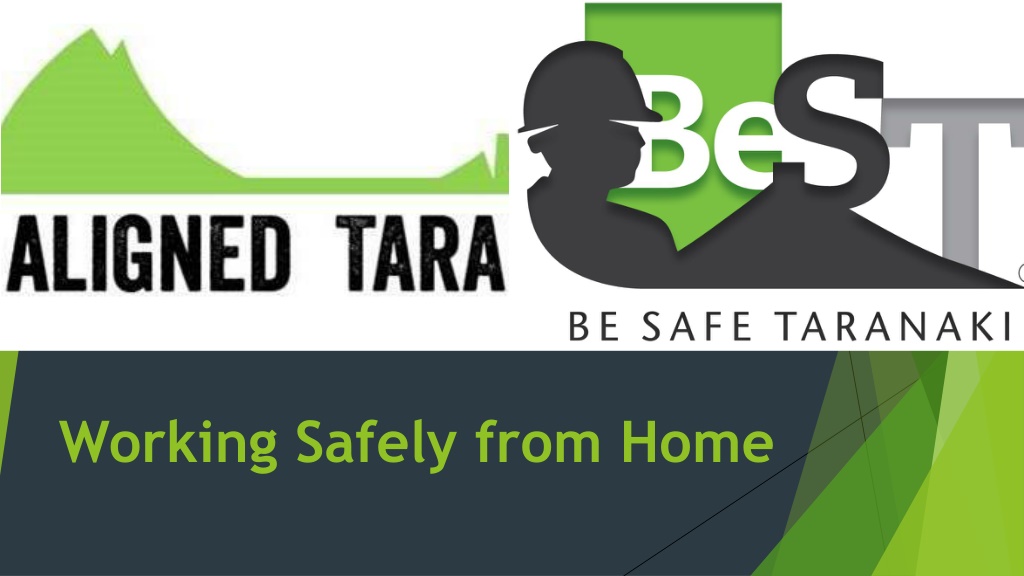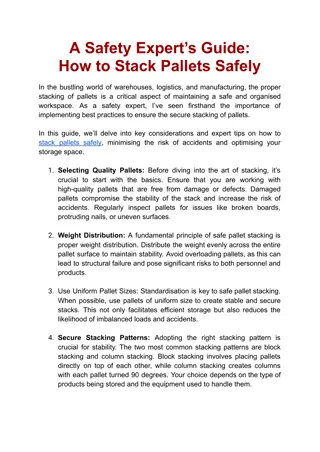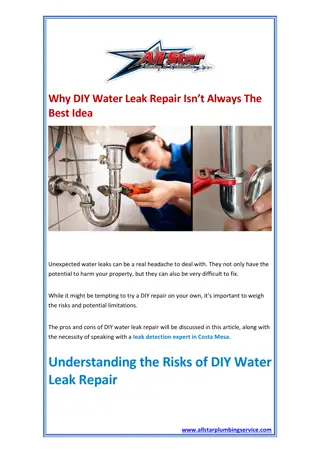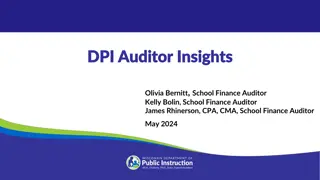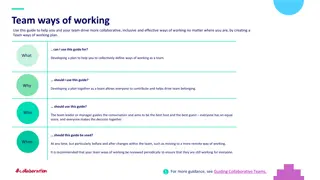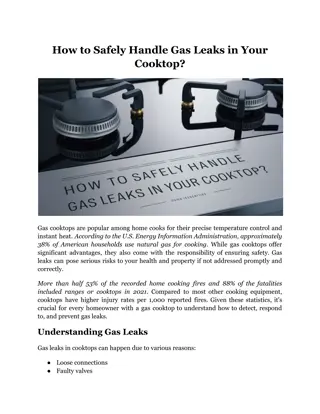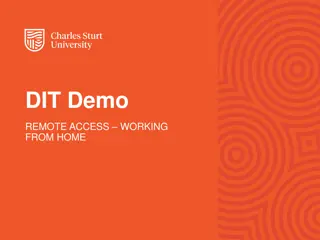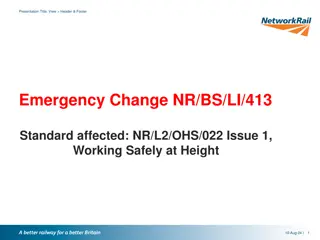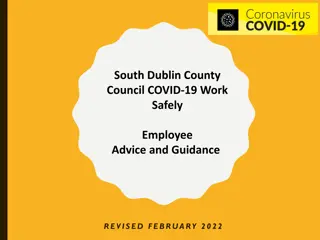Guidelines for Working Safely from Home
This guideline outlines the purpose, background, and responsibilities related to working from home. It emphasizes the importance of ensuring a safe and healthy work environment for remote team members. Managers are tasked with identifying and managing risks, documenting assessments, supporting staff, and providing necessary equipment. Team members are expected to follow approval processes, set up workstations properly, report any discomfort, and take responsibility for issued equipment. Resources for working productively from home are also provided.
Download Presentation

Please find below an Image/Link to download the presentation.
The content on the website is provided AS IS for your information and personal use only. It may not be sold, licensed, or shared on other websites without obtaining consent from the author. Download presentation by click this link. If you encounter any issues during the download, it is possible that the publisher has removed the file from their server.
E N D
Presentation Transcript
Purpose of the Guideline At times staff members may be required to carry out work at home. This may be as part of a routine work arrangement or may be required as a response to outside factors e.g. COVID-19 level requirements. The purpose of this guideline is to assist in identifying and addressing issues so team members may safely work at home. Additionally, this guideline seeks to minimise risks to your organisation by including aspects of information privacy and security controls.
Background Working from home may be required as part of a response to an organisational situation or may be negotiated as part of flexible work arrangements by arrangement with managers. In either case the PCBU has a responsibility to ensure that the team member remains healthy and safe in the home work situation. The PCBU also has a statutory duty under the Privacy Act 2020 to ensure all information collected remains secure and private.
Responsibilities Managers Ensuring formal or informal processes for permission to work at home as part of normal duties are complied with. Identifying and managing risks associated with work at home - this should preferably be discussed prior to permission being given to work at home on a long term or regular basis. Documenting any assessment processes undertaken prior to or during working at home. Supporting staff to be familiar with this guideline including the self assessment process. Taking steps to provide a supportive working environment for team members including regular general communication and health and safety discussions. Referring team members for workstation assessments where required. Participating in periodic, scheduled reviews to ensure that no issues have arisen due to working at home and controls remain suitable and effective. Approving and recording the allocation of any equipment for use at home.
Team Member Follow the process for approval of working at home. Working through guidelines and setting up workstations as best as possible in the home environment. in workstation required. Participating assessment processes if Reporting any pain or discomfort that is associated with workstation use to supervisor or manager as soon as possible. Be responsible for care and return of any issued equipment.
Working Productively from Home Webinar - HASANZ https://www.hasanz.org.nz/site_files/11371/upload_files /WorkingProductivelyfromHomeWebinar15April2020(1).pdf ?dl=1 WorkSafe Ergonomics for using Computers https://besafe.nz/wp-content/uploads/2021/03/977WKS- 2-work-related-health-guidelines-for-using-computers.pdf Working From home during Covid 19 https://www.healthandsafety.govt.nz/assets/Documents/2020- working-from-home-during-COVID-19.pdf Working from Home Guidance https://www.healthandsafety.govt.nz/assets/Documents/280420- Supporting-workers-to-work-from-home.pdf
Responding to working from home requests and managing working from home Recognise that discussions will be needed to adapt this guideline to suit a team member s personal circumstances. All plans need to be documented for future reference. All assessments and planning should take into account risk such as physical, ergonomic, or working alone/isolation. https://www.employment.govt.nz/workplace-policies/productive- workplaces/flexible-work/ Link to above site gives access to - Flexible Work Toolkit Flexible Work Application Form Employers/Managers Response Form Information for Employees
Team member pain or discomfort If at any stage the team member is having issues with pain or discomfort they associate with their work or workstation the following steps are recommended: Carry https://besafe.nz/wp-content/uploads/2021/03/977WKS-2-work- related-health-guidelines-for-using-computers.pdf out self assessment to identify any issues. Refer Discuss any issues/equipment needs identified with manager If issues continue, ask your Supervisor for a further workstation assessment. This may be carried out in person or virtually. Action recommendations from workstation assessment if possible. Pain and discomfort issues should be recorded for future reference.
Provision of equipment for regular work at home as part of normal duties Team members are encouraged to set up a work area in the home that can be used as a regular work space. This should align with ergonomic best practice guidance as far as possible.
Provision of equipment for work at home during organisational or emergency response If national or local emergency or organisational conditions require team members to work at home for an extended period, it may be necessary to shift items of equipment to team member s home. Controls for this process: Equipment should be shifted to the team member s working from home site on the basis of individual requirements to safely work at home. All items shifted to a team member s home should be listed for tracking purposes. Ensure that items are shifted in a safe manner, minimising risk from manual handling.
Security and Privacy Security and privacy of information and data should be discussed with the team member prior to permission being given for work at home. How this will be maintained should be included in the Working from home plan (see also the contractual obligations within that staff members employment agreement). All policies that apply to employees who are working in the office, also apply when employees are working remotely. It is the employee s responsibility to keep all work information secure especially customer records and any other sensitive material. It si also important that reasonable care is taken of company information and equipment.
Employees responsibilities When working remotely, the employer should ensure that employee s: Comply with the guidelines contained in this document as well as all other organisational policies and procedures Only work from a location that is safe and suitable for working remotely Comply with all health and safety requirements Do not work during annual leave or sick leave specified on a medical certificate Do not hold meetings with customers or other employees at their home Make necessary childcare arrangements and don t treat working from home as a substitute for childcare Take reasonable steps to keep the organisation s technology, equipment and information safe and in working order. TIP: Cut and paste these employee responsibilities into a document and both sign to evidence mutual understanding and clearly communicate conditions of the arrangement.
Promoting good working at home practices It is important that the team member has access to information on how best to manage working from home for maximum health, safety, comfort, and productivity especially in cases where the working from home arrangement is long term and part of normal working arrangements. Any issues with any of the above should be managed proactively and quickly. Review of working from home arrangements Regular review dates should be set between the line manager and the team member to ensure the arrangement is still satisfactory and safe. Records of the review should be kept by the line manager.
